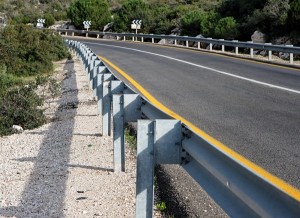Guardrail Safety: Facts and Tips
Written by Cooper & Friedman PLLC on November 18, 2015
Guardrails are created to ensure safety on the roadways and help vehicles  that are forced off of the road to remain safe and upright. While these rails are intended for driver safety, they sometimes also become hazards for some drivers unable to maintain control of their vehicles. Guardrails become a threat to drivers when combined with high speeds, size, and orientation of the vehicle as it comes into contact with the guardrail. Because guardrails are intended to deflect vehicles, sometimes drivers get punctured or become airborne when contact is made.
that are forced off of the road to remain safe and upright. While these rails are intended for driver safety, they sometimes also become hazards for some drivers unable to maintain control of their vehicles. Guardrails become a threat to drivers when combined with high speeds, size, and orientation of the vehicle as it comes into contact with the guardrail. Because guardrails are intended to deflect vehicles, sometimes drivers get punctured or become airborne when contact is made.
There are four common types of guardrails. These range from inexpensive materials with weak protection, to the strongest and most expensive types of protection. Cable and wood posts are the most simple type of guardrails, progressing then to steel and wood or metal posts, steel box-beams and finally, concrete barriers. The type of material used for guardrails plays an important role in the safety of your vehicle, as well as the safety of your passengers when striking this safety system.
Unfortunately, too many stories on the news involve a driver striking a guardrail at fatal speeds. It was reported in 2005 that guardrail collisions accounted for 1,189 fatalities and more than 35,000 crash injuries. And motorcyclists accounted for nearly one out of three guardrail fatalities. Certain types of guardrails have also been under recent scrutiny. For example, in October 2014, the Kentucky Transportation Cabinet (KYTC) joined a number of other states to temporarily suspend the installation of the ET-Plus guardrail end treatment, awaiting results from crash tests mandated by the Federal Highway Administration.
5 Tips to Know about Guardrail Safety
Because guardrails are intended as a safety feature on the road, it may be helpful to understand how to use this protective device to your advantage. Here are some general tips to avoid guardrail collisions.
1. Drive the Speed Limit: Most of these rails are designed to take the impact of a vehicle traveling under 100 mph. Driving the speed limit will reduce your chances of driving off of the road, lowering your risk of collision and injury.
2. Get Rid of Distractions: Limiting the time you take your eyes off the road will help you avoid guardrail collisions, as well as any impact made with other vehicles. Try and avoid using your cellphone when driving on the expressway at high speeds.
3. Wear a Seatbelt: Whether you strike the guardrail or another vehicle, wearing a seatbelt will help you avoid injuries during a crash. You should always wear a seatbelt when operating or riding in a vehicle to ensure optimal levels of safety.
4. Avoid Driving under the Influence: Speeding down the highway while intoxicated puts you and other drivers at a greater risk for an accident. Alcohol and drug use while driving is linked to poor judgment, reduced reaction times, impaired vision and many other limitations.
5. Prepare in Advance: Whether you are an experienced driver or a novice, learning how to avoid or deal with a crash will help you in the long run. Most accidents are not predictable, but learning how to handle a car accident or motorcycle collision before it happens could save you a lot of anxiety.
Just because guardrails are intended for safety doesn’t mean these can’t become another hazard on the roadways. Keep these facts and tips in mind as a preventative and cautionary measure when you are traveling out on the roadways.

